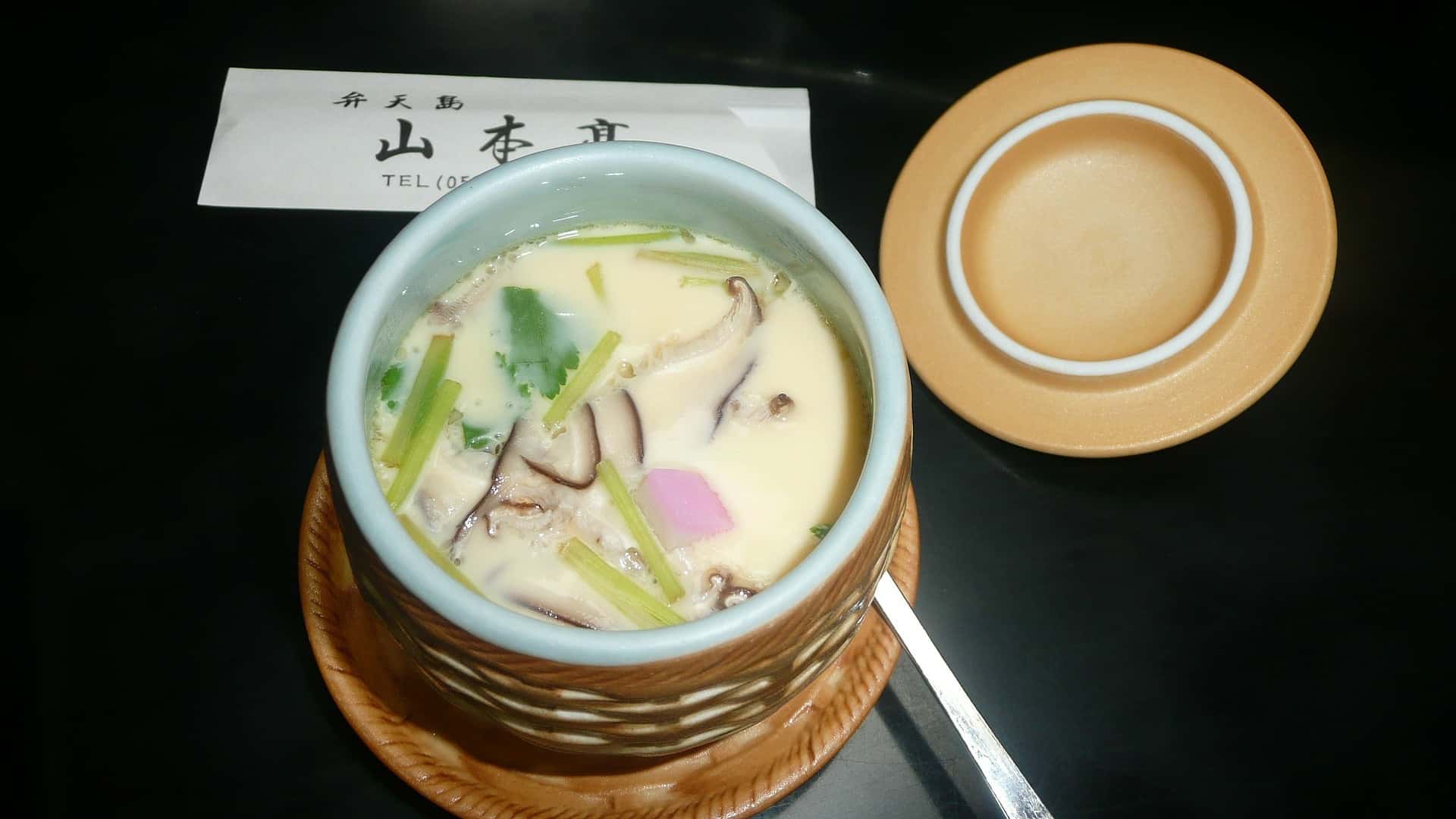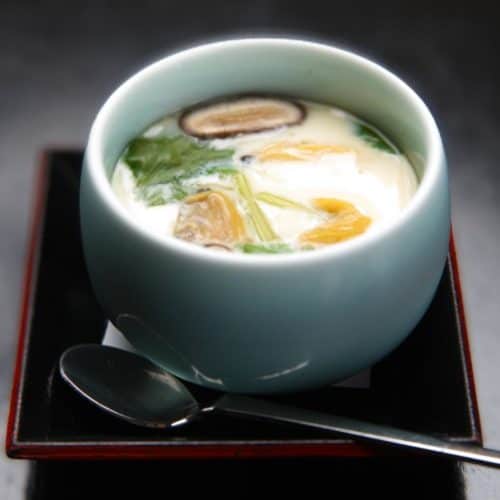Chawanmushi Japanese Dashi Egg Custard Recipe
If you’re in the mood for a thick soup-like hearty meal that fills, chawanmushi should be the next thing on your to-make list.
I’ll show you exactly how to get the right flavor and texture in this Japanese custard recipe.
So let’s make it!


Check out our new cookbook
Bitemybun's family recipes with complete meal planner and recipe guide.
Try it out for free with Kindle Unlimited:
Read for freeIn this post we'll cover:
How to make chawanmushi at home

Chawanmushi (Japanese Egg Custard)
Ingredients
- 1 cup water warm
- ¾ tsp dashi powder
- 4 small shiitake mushrooms dried
- ¼ cup water hot
- ½ tsp soy sauce
- ½ tsp mirin
- 4 medium shrimp peeled and deveined
- 4 slices kamaboko
- 4 mitsuba leaf stems
- 2 medium eggs
Instructions
- Pour 1 cup of warm water and the Dashi powder into a large mixing bowl and mix thoroughly.
- Next step is to soak the shitake mushrooms in a 1/4 cup of hot water in a small bowl and wait for the mushrooms to soften (this may take a few minutes).
- Cut the mushrooms into thin slices and save the 1/4 cup of hot water that you soaked the mushrooms with for later use.
- This time pour the mushroom soaked water into the Dashi stock; add the mirin and soy sauce and then mix them thoroughly.
- Blanch the shrimp in hot water for 30 seconds and then divide them evenly into 2 teacups (or ramekins of about 230 ml each).
- Divide up the mitsuba, kamaboko, and mushrooms even as well, then save a very thin slice of each of the kamaboko (about 1/8th of an inch thick) and allow it to float on the top of the dish to add color to the cuisine.
- Crack the eggs in a separate mixing bowl and whisk them until they become frothy. Pour in the Dashi as well and mix them thoroughly, then pour it over a strainer and put the resulting liquid into the individual teacup leaving a space about half-an-inch at the top.
- Season it with what’s left of the kamaboko (optional).
- Get a large metal pot and pour water into it until it fills the pot with 2 inches of water from the bottom. Turn on the stove and heat up the water until it reaches its boiling point, then place the teacups/ramekins in the pot, but make sure that the water is at least an inch lower than the rims of your ramekins so that it won’t sip through and contaminate the ingredients.
- Place an aluminum cover over each ramekin so that steam won’t also get into the cup. Reduce the temperature to medium-low, cover the pot with a lid, and then steam the ingredients for about 10 – 15 minutes, or until it becomes tender or cooked.
- To test, stick a chopstick or toothpick through; if the liquid is clear, it's ready to eat.
Cooking tips
You can also use 1 cup of dashi stock if you have that instead of the powder. That comes down to the same amount of dashi in the dish.
The kamaboko slices should be cut very thin, otherwise they’ll be too large a bite compared to the rest of the ingredients. You can even cut the slices straight off of frozen kamaboko and add it to the hot custard.
The ramekins are the small bowls you pour the custard into, but any bowl will do of course. You get the best results if it’s a bowl with edges straight down instead of slanted or curved like with some bowls though.
Substitutes
You really need dashi in this dish to get the best flavors. Normally, I would suggest replacing dashi with shiitake mushrooms for flavor, but those are already in there so that would also not do.
You can replace some of the other ingredients though:
Shiitake substitute for chawanmushi
If you don’t have any shiitake, oyster mushrooms could do well as a substitute. Be sure to cut them into little pieces so they can fit into one bite and your meal will still be very fulfilling.
Kamaboko substitute for chawanmushi
Fish cake is the best substitute because that’s what kamaboko is. Surimi, the crab meat sticks, is also a good substitute.
Mirin substitute for chawanmushi
Some sake with a little sugar would be a perfect substitute, but if you don’t have that use a little dry white wine with sugar and that’ll go in the right direction for the flavor you’re going for here.
Mitsuba leaf stems substitute
If you don’t have mitsuba, you can also use parsley. The flat leaf is perfect, because they also have the thin stems you can use in the same way you could use mitsuba stems.
Curly leaf parsley is different in the type of stems so that wouldn’t really work the same.
How to serve and eat chawanmushi
Chawanmushi is one of few dishes the Japanese eat with a spoon instead of chopsticks. That’s because of it’s texture, obviously. It’s not a dessert but rather a side dish. It’s savory and salty and therefore not a dessert like many other custards.
How to store leftovers
If you have leftovers, be sure to store them in the fridge. They’ll last for a day or two but any longer and the egg will start to spoil.
Reheating is possible, but know that the egg will cook a bit more and get tougher. It’s still edible, but not as smooth as it was when you first made it.
Chawanmushi variations
There are many chawanmushi variations out there. You can add different vegetables or even fruit to them.
As I said, chawanmushi is savory so adding sweet fruit doesn’t really make sense. But you could add some thinly sliced citrus fruits like yuzu or lemon to give it a nice zing.
Vegetables that go well in chawanmushi are things like asparagus, spinach, and even diced tomatoes.
You can get very creative with this dish, so don’t be afraid to experiment a bit.
Similar dishes
If you like chawanmushi, you might also like tamago kake gohan which is a dish with raw egg and rice.
Another similar dish is shirred eggs which are basically baked eggs. They don’t have the same soupiness to them but are still custards nonetheless.
And finally, there’s the classic French dish, oeufs en cocotte, which are eggs cooked in a ramekin with cream. They’re very similar to chawanmushi but not exactly the same.
Conclusion
Now that you know all about chawanmushi, it’s time to get cooking! I hope you enjoy this dish as much as I do.
Also read: these are the best recipes that use dashi you can make right now
Check out our new cookbook
Bitemybun's family recipes with complete meal planner and recipe guide.
Try it out for free with Kindle Unlimited:
Read for freeJoost Nusselder, the founder of Bite My Bun is a content marketer, dad and loves trying out new food with Japanese food at the heart of his passion, and together with his team he's been creating in-depth blog articles since 2016 to help loyal readers with recipes and cooking tips.

